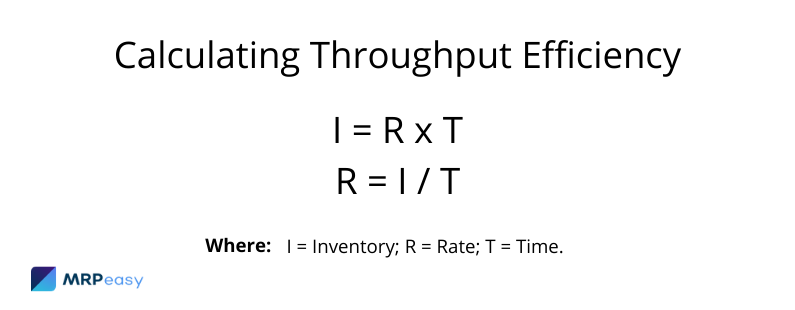What is Throughput Time?
To put it bluntly, throughput time is the time required to make a product. But it’s not only about standing by the assembly line with a stopwatch.

You can also listen to this article:
The goal of manufacturing is to supply its customers with quality products at a price that brings in maximum profit to manufacturers while staying competitive.
While the cost of materials, labor, taxes, and other operating expenses are important in the overall cost structure to deliver those goods, the component that makes it all work is time.
Quote time, lead time, and other measurements are common KPIs in assessing a company’s success.
But few measurements are more important for a company’s ability to deliver than Throughput Time.
What is Throughput Time?
Throughput time is the measured amount of time that is required to complete a finished product from beginning to end.
This includes its beginnings as raw material all the way through the completion of finished goods that are ready to ship.
Because the speed of materials and assembly as they pass through various manufacturing stages is what all other aspects of business are based on, throughput time is critical to understanding how materials, labor, capital investment, and other costs are measured.
It is also a key aspect to supply chain planning, forecasting, capacity planning and scheduling.
Because so much of throughput time is not spent in actual process or machine time, accurate throughput time measurements give manufacturers a way to build improvements into the production cycle to shorten throughput time and improve performance and efficiency.
Throughput time is the sum of four different time intervals:
- Processing Time – Processing time is the time spent in actual production on a machine. Blending, spinning, grinding, riveting and endless other automated steps as well as manual assembly are all processing time where the raw materials are transformed into finished goods in a mechanical process.
- Inspection Time – Because different types of goods require different levels of quality monitoring, inspection time consists of the cumulative time required to check components, mixes, or sub-assemblies as it progresses through the manufacturing process. This can include automated or electronic testing as well as manual inspection that can range from feel, stress testing, visual confirmation, and even things such as taste and smell.
- Move Time – While many factories are constructed with optimized product flow in mind to reduce movement and staging, other companies may be using older buildings or eclectic space that requires an abundance of staging and moving time for Work in Progress (WIP). Regardless of the operation, move time must be accurately counted and included in throughput time. This includes the time to move sub-assemblies or partially processed material into and out of production areas as well as the time required to move between workstations.
- Queue Time – Also referred to as “wait time”, queue time is the wait time that occurs prior to processing, inspection and moving.
By adding these time cycles together, one can arrive at the total throughput time required to complete each unit.
This allows for products to be costed correctly for use in other business activities such as planning, pricing, and Return on Investment (ROI) for capital expenditures.
Manufacturers can also use these cycles to look for ways to improve the manufacturing process to make it more efficient and cost-effective.
This is especially true in move time, inspection time, and queue time where Lean Manufacturing, Six Sigma, and other continuous improvement programs can significantly impact cost by reducing those times.
And as more and more operations move to digital conversions, even the processing time can be analyzed to identify trends and microtrends to improve that time as well.
Calculating Throughput Time
While the basic formula for throughput time was discussed above, there are other calculations related to throughput that can be used to assess performance as well. These include:
Profitability – A rough equation where throughput is equal to net sales minus variable costs.
Throughput Efficiency – Throughput efficiency can be calculated using the starting inventory in conjunction with total throughput time and throughput rate. Because manufacturers often make many more units at the same time, establishing a throughput rate allows businesses to understand the microdata of producing just one unit. This can be arrived at by the equation Inventory (I) equals Rate R times Time (T), or I = R x T. Inversely, you can use an established time and inventory level to measure the rate, resulting in R = I / T.

Analyzing Throughput Time
Throughput time can be a valuable tool in analyzing business processes and understanding performance to goals.
It can point to important ROI information and help identify where improvements can be made and when new capital equipment should be purchased.
It also allows manufacturing companies to make important financial decisions for their business.
The process of using throughput data to determine whether additional investment is required for production is called the system approach.
The system approach to throughput uses three formulas:
- Revenue – Total Variable Expenses = Throughput
- Throughput – Operating Expenses = Net Profit
- Net Profit/Investment = Value of Investment
These formulas show the importance of accurately measuring and calculating throughput time to yield valuable financial insight.
Benefits of Throughput Time
There are several benefits to understanding throughput time.
First, knowing throughput time allows manufacturing businesses to understand what is needed to meet demand. This may trigger additional hours, added shifts or the purchase of new equipment.
Second, throughput time helps companies manage supply chain and inventory.
This can help negotiate bulk contracts for raw materials, plan accurate delivery for companies using Just in Time (JIT) production modes or to stagger deliveries to improve cash flow and manage warehouse space with their associated holding costs.
Finally, understanding throughput time allows manufacturers to manage their workflow and improve manufacturing efficiency.
By using established continuous improvement methodologies, manufacturing managers can work to reduce the time for inspection, queue and waiting, and hone those for the process.
They can also couple these methodologies with flexible and agile MRP and ERP software to automate the tasks and reflect in accurate Bills of Material (BOM) to free them up for further improvement initiatives.
You can read more about the advantages of using an MRP system from this list of 8 Major Benefits of MRP for Manufacturing Business.
Conclusion
Throughput time is a critical component in any manufacturing operation. It allows companies to gain valuable insight into their business and provides a roadmap for where to work for improvements.
It also drives decision-making at the enterprise level for financial and investment decisions.
You may also like: What Is Cycle Time in the Manufacturing Process?




